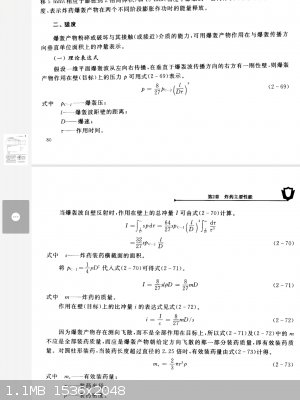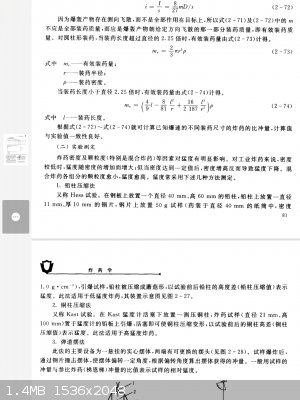| Pages:
1
2 |
Microtek
National Hazard
   
Posts: 830
Registered: 23-9-2002
Member Is Offline
Mood: No Mood
|
|
| Quote: |
There is an active charge length "La". At L>La pulse does not grow. |
Precisely. In general, using the charge length divided by the VOD to calculate an explosion duration is irrelevant to the matter of brisance. The book
PLSHY is quoting seems to be using some very outdated methods. Could you give us a proper literary reference, so we can look at the source?
| Quote: |
explosion pressure*time=i, which is a unit of impulse, It is not a viscosity unit, I=FT is an expression of impulse |
No, your maths are wrong - you use both upper and lower case letter "i" to denote impulse, and the two expressions are not equal. Indeed, they are not
even in the same units. Pressure*time is not impulse, it is viscosity.
Regardless, I think this is not a fruitful discussion, so I won't be commenting further on your idea of brisance.
|
|
|
MineMan
National Hazard
   
Posts: 998
Registered: 29-3-2015
Member Is Offline
Mood: No Mood
|
|
Agreed. Don’t see the point of this discussion. Anyways. It will of course always be VOD, density, volume of gases and heat of detonation. Tho that
changes with the addition of nano metals.
|
|
|
PLSHY
Hazard to Self
 
Posts: 88
Registered: 30-7-2023
Member Is Offline
|
|
Well, I will attach my book, my book was written in the 2000s, if you are interested, you can translate it yourself
 
|
|
|
PLSHY
Hazard to Self
 
Posts: 88
Registered: 30-7-2023
Member Is Offline
|
|
I always think that my point of view is correct, but it may be my poor expression ability plus translation that caused this failed discussion. I hope
that the books I gave can provide some help for DennyDevHE77. Finally, I want to say, distinguish between uppercase and lowercase Impulse and
specific impulse are common mathematical methods, which are also used in the book.
|
|
|
OneEyedPyro
Hazard to Others
  
Posts: 279
Registered: 7-10-2015
Member Is Offline
Mood: No Mood
|
|
Quote: Originally posted by PLSHY  | | I always think that my point of view is correct, but it may be my poor expression ability plus translation that caused this failed discussion. I hope
that the books I gave can provide some help for DennyDevHE77. Finally, I want to say, distinguish between uppercase and lowercase Impulse and
specific impulse are common mathematical methods, which are also used in the book. |
The language barrier is an issue but don't worry about it, your English is likely better than nearly all of the forum members Chinese.
The issue is that you're using unfamiliar and undefined terms like 'jerk' and violence. Beyond that, when we respond with established facts you seem
to argue either due to the language barrier or because you don't fully understand the topic but believe you do.
|
|
|
Etanol
Hazard to Others
  
Posts: 143
Registered: 27-2-2012
Member Is Offline
Mood: No Mood
|
|
Quote: Originally posted by PLSHY  | | Well, I will attach my book, my book was written in the 2000s, if you are interested, you can translate it yourself |
The language of mathematics is universal. Thanks for the scans.
I found these calculations in my language and was able to match them.
Pc-j - is short for Chapman–Jouguet Pressure. This is the detonation pressure.
But your article uses its approximate value of 1/4 ro D^2. It is only true for CHNO-compounds at 1.0 g/cc and the authors of your paper explicitly
state that they are using 1.0 g/cc.
I - is really the impulse when a detonation wave (a charge of length L) is reflected from a rigid wall.
i=I/S
But this is purely a mathematical problem. This is detonation in a perfectly rigid non-deformable tube.
In a real explosion, the lateral expansion of detonation products takes place. L cannot be infinite. There is an L/R parameter of a cylindrical charge
that limits this model. In my book (L/R)max=4.5.
You cannot use formulas 2-70...2-72 to calculate real impulse.
Formula 2-73 is the active mass of a real cylindrical charge at L>=4.5R.
Formula 2-74 is the active mass of the shorter charge.
You must insert the active mass, not the total mass!, into formulas 2-71 and 2-72 to get the shock wave reflection impuls.
But it will not be accurate, because you used an inaccurate detonation pressure formula and the real wall is elastic.
Oooh, I understand your problem.
No, no, no.
Because this definition does not take into account the scale effect.
The same substance, by your definition, will have different brisance depending on the diameter of the charge.
Impulse per unit area for a charge of fixed length and area.
Or the impulse per unit area and divide by the length of the charge.
Or the impulse per unit area and divide by the radius of the charge.
[Edited on 27-8-2023 by Etanol]
[Edited on 27-8-2023 by Etanol]
|
|
|
PLSHY
Hazard to Self
 
Posts: 88
Registered: 30-7-2023
Member Is Offline
|
|
Quote: Originally posted by Etanol  | Quote: Originally posted by PLSHY  | | Well, I will attach my book, my book was written in the 2000s, if you are interested, you can translate it yourself |
The language of mathematics is universal. Thanks for the scans.
I found these calculations in my language and was able to match them.
Pc-j - is short for Chapman–Jouguet Pressure. This is the detonation pressure.
But your article uses its approximate value of 1/4 ro D^2. It is only true for CHNO-compounds at 1.0 g/cc and the authors of your paper explicitly
state that they are using 1.0 g/cc.
I - is really the impulse when a detonation wave (a charge of length L) is reflected from a rigid wall.
i=I/S
But this is purely a mathematical problem. This is detonation in a perfectly rigid non-deformable tube.
In a real explosion, the lateral expansion of detonation products takes place. L cannot be infinite. There is an L/R parameter of a cylindrical charge
that limits this model. In my book (L/R)max=4.5.
You cannot use formulas 2-70...2-72 to calculate real impulse.
Formula 2-73 is the active mass of a real cylindrical charge at L>=4.5R.
Formula 2-74 is the active mass of the shorter charge.
You must insert the active mass, not the total mass!, into formulas 2-71 and 2-72 to get the shock wave reflection impuls.
But it will not be accurate, because you used an inaccurate detonation pressure formula and the real wall is elastic.
Oooh, I understand your problem.
No, no, no.
Because this definition does not take into account the scale effect.
The same substance, by your definition, will have different brisance depending on the diameter of the charge.
Impulse per unit area for a charge of fixed length and area.
Or the impulse per unit area and divide by the length of the charge.
Or the impulse per unit area and divide by the radius of the charge.
[Edited on 27-8-2023 by Etanol]
[Edited on 27-8-2023 by Etanol] |
Finally someone understands, yes, what I said has always been the ideal
detonation in theory. I said a few days ago that if you need to convert it into an actual detonation, you need to bring in calculus, so what I said
has always been It is ideal. In addition, charge efficiency * theoretical brisance = actual brisance, and the calculation of charge efficiency
requires calculus
|
|
|
Etanol
Hazard to Others
  
Posts: 143
Registered: 27-2-2012
Member Is Offline
Mood: No Mood
|
|
Quote: Originally posted by PLSHY  |
to convert it into an actual detonation,...
charge efficiency * theoretical brisance = actual brisance, and the calculation of charge efficiency requires calculus |
In different languages, there are two concepts of brisance:
1. Brisance as the action of an explosion on solid objects
2. Brisance as a quantitative measure to compare different substances
Of course, the effect of an explosion depends on the shape, size, shell, critical detonation diameter, and the quality of the initial shock. It's all
charge efficiency.
But I meant something else.
If we consider that "brisance" is a measure of comparing substances, then definition
is mathematically incorrect.
This is some formula or raw result of the experiment. But not Brisance.
It will be correct if:
Quote: Originally posted by PLSHY  |
Impulse per unit area for a charge of fixed length and area.
Or the impulse per unit area and divide by the length of the charge.
Or the impulse per unit area and divide by the radius of the charge.
|
Detonation pressure characterizes brisance quite well. However, it is very difficult to measure it experimentally. Therefore, deformation, impulse,
and speed are experimentally measured.
At the same time, they try to choose the conditions of the experiment so that the influence of the shape, shell, size, critical diameter and detonator
does not affect the result of the comparison.
The scale factor should not be so manifest in the brisance formula, whatever it may be.
|
|
|
PLSHY
Hazard to Self
 
Posts: 88
Registered: 30-7-2023
Member Is Offline
|
|
Quote: Originally posted by Etanol  | Quote: Originally posted by PLSHY  |
to convert it into an actual detonation,...
charge efficiency * theoretical brisance = actual brisance, and the calculation of charge efficiency requires calculus |
In different languages, there are two concepts of brisance:
1. Brisance as the action of an explosion on solid objects
2. Brisance as a quantitative measure to compare different substances
Of course, the effect of an explosion depends on the shape, size, shell, critical detonation diameter, and the quality of the initial shock. It's all
charge efficiency.
But I meant something else.
If we consider that "brisance" is a measure of comparing substances, then definition
is mathematically incorrect.
This is some formula or raw result of the experiment. But not Brisance.
It will be correct if:
Quote: Originally posted by PLSHY  |
Impulse per unit area for a charge of fixed length and area.
Or the impulse per unit area and divide by the length of the charge.
Or the impulse per unit area and divide by the radius of the charge.
|
Detonation pressure characterizes brisance quite well. However, it is very difficult to measure it experimentally. Therefore, deformation, impulse,
and speed are experimentally measured.
At the same time, they try to choose the conditions of the experiment so that the influence of the shape, shell, size, critical diameter and detonator
does not affect the result of the comparison.
The scale factor should not be so manifest in the brisance formula, whatever it may be.
|
Yes, I think I finally understand what you mean. What you want to say is that the brisance is a fixed value
for a type of explosive. I think I can understand this. This is also related to your reply. The difference is Appears on the definition! We are used
to defining brisance as the action on an object, and the disagreement with the mainstream definition led to this discussion. Thanks for pointing out
exactly what the problem is, I think I understand!
|
|
|
| Pages:
1
2 |
|